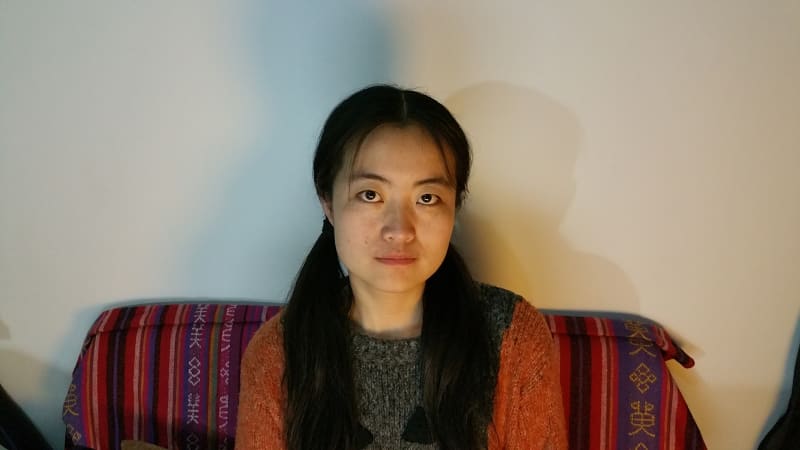Specifically speaking, I am not interested in a concrete thing, but rather everything besides what I am writing about, the topic I have selected, as well as all its possible variants and the relationships in between; it is everything that this topic may encompass in time and space.
- Italo Calvino "American Lectures"
The backdrop of the animation "Lunar Dial" consists of acrylic paintings Gao Yuan created in the past six years. Green trains, open streets flanked by lowrise buildings, a tall parking pole set against the night city scape, dilapidated, lonely, and possessing a stale industrial stench, like the forgotten ruins of a once mighty city and its periphery, ruthlessly plundered of former lustre. Yet, during the period of a few years, Gao Yuan rarely left her Beijing studio to conduct rural 'ethnography'. "Lunar Dial" has a distinct structure and rhythm. It is obvious that the paintings included within the animation are not focused on the technical handling of the interior of the painting, but also contain 'animated elements', that is, a state of consciousness that changes the nature of the 'momentum' of the animation.
“Eternal Return” features “Lunar Dial” and paintings that appear in it. Within one of the paintings, “Artificial Beach”, three stoplights are erected in a harbor surrounded by high-rise buildings, their lights mingling with the sunrise (or perhaps, sunset). With no roads in the water, the stoplights appear to be rulers of little relevance. Thus, a sentimental landscape becomes an expression of old-fashioned ‘order’.
This symbolic divergence broadens the scope of the metaphor until it seems meaningful. Throughout the animation, the artist’s approach remains direct and images are simple, with repeated action so that objects contain the ideographic system that initially captures viewers’ attention. Objects are simplified to an extent that can be identified, but not reduced to mere lines and color.
If some animation undergoes change according to the tautology of 'A equals B', resulting in the continuous transformation of images (young artist Wang Haiyang's "Animated Painting Trilogy" belongs in this category) and embodiment of a visual way of thinking, then "Lunar Dial" is more akin to a film. Like Alain Resnais' "Last Year at Marienbad" (1962), Gao Yuan uses montage to create a more complete narrative and a suspenseful temporal 'wormhole'. Three obscured figures ride a bicycle, row a wooden canoe and walk throughout the animation. The three figures slowly approach 'closer' to a 'destination' under a moonlit sky. It is worth mentioning that 'closer to a destination' is only a rhetoric; their journeys do not end with the conclusion of the animation, and at no point is a sense of forward progression, hardships of the journey or joy of reaching a final destination conveyed. By using a cyclical narrative, many other topics with rich meanings are interspersed throughout the 'journey', creating a visual rhythm that includes: flowing water (water sounds, droplets, an ocean displayed on a phone camera), moonlight and other light (an incandescent bulb, traffic lights, streetlights, flashlights), and objects representing knowledge (a human anatomy, library, flipping pages of a text, and burning book) and so forth. These themes incorporate visual, form, concept and metaphor. They are arranged to intermittently 'attack' and switch, summoning viewers to form an impression with the fragmented and difficult to digest scenes that create a certain rhyme and meter. For example, flowing water appears in the opening scene and becomes a weak element (water droplets under the simmering glow of street lamps), embellishing the ever more prominent presence of the moon throughout the animation.
According to French philosopher Bernard Stiegler, a temporal object is temporal when its flow coincides with the stream of consciousness of which it is the object. It is precisely because of this that "Lunar Dial" effectively mobilizes viewers' consciousness with visual montage. Perhaps we can cite German philosopher Edmund Husserl's phenomenological concept of the 'second hold' to explain the strange ambiguous feeling of those already passed 'moments' that precede the present 'moment' that although gone, remain temporarily in the present 'moment', like a lingering demon spirit, simultaneously present and absent (the exhibition name "Eternal Return" alludes to this). Similarly, the shape of consciousness is also embodied in the transmission of the media itself: the language of animation exhibits inferior documentary utility compared to an image, and presented as a sense of encroachment, is digested again, alluding to a richer image, as well as becoming more similar in format to the visual information of the mind.
Gao Yuan incorporates her own state of consciousness in her paintings and animation, allowing these media to constantly recount the past while flowing toward the future, forming a self-contained structure. "Lunar Dial" refers to the ancient time measurement tool based on the shadow of moonlight. Due to the oblong shape of the lunar orbit, deviation is very common. In this way, the lunar dial incorporates uncertainty generated by cyclical movement and conversion. Reality is determined by intuition and feeling of the formation of a silhouette, flowing out like a dreamlike implication.



